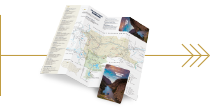Notes From the Road: Calamity Jane: Yellowstone Country Legend
We’ve all heard of Calamity Jane, right? Perhaps you’ve even nicknamed your two-year-old "Calamity Jane" after her destructive tendencies. Or perhaps you were just a big Bonanza fan (hey, no judgments here). What you probably don’t know is that Calamity Jane’s life of, well, calamity, took her through Montana’s Yellowstone Country, where she settled for a time, in between bouts of her nomadic life.Born Martha Jane Canary, in 1852, Calamity Jane grew up primarily in Mercer County, Missouri. In the winter of 1864-1865, at the near end of the Civil War and when she was 12 years old, her father, Robert, loaded up their wagons and brought Martha Jane, her mother, her two little brothers and her three little sisters west toward Virginia City, Montana.
On the (often harrowing) journey from Missouri, over mountains and across raging rivers, during rain, snow, and extreme sun, Martha Jane learned to shoot, hunt and ride with dexterity, often showing talent as a marksman. It’s this education in the wilderness that led to her reputation as a wild woman.
On the way to Virginia City, Martha Jane’s mother, Charlotte, died from pneumonia, leaving Martha Jane as the woman of the family, to care for her brothers and sisters. It didn’t get much better when, a year later, in 1867, her dad, Robert, died while the family was living in Salt Lake City, leaving 15-year-old Martha Jane as the head of a six-person household.
In the spring of 1866, the Canary family arrived in Virginia City. Not much is known about how long they stayed, where exactly they lived and how they made money, though presumably, Robert entered the mining trade. At that time, nearly 8,000 people lived along the 14-mile stretch of mining camps (with the most prominent being Virginia City). Compare that to 10 years later when the city’s population had dropped to below 800 (and of course, now, where the population is around 130).
It’s said that the Canary family’s initial goal was to settle in Virginia City, but moved on to Salt Lake in the same year. After Robert died, Martha Jane began her journeys around the west. She joined Colonel George Custer’s army as a scout, using her shooting and riding talents well. She became a prominent figure in the fighting between the US Army and Native Americans, with plenty of stories about her ruthlessness and ability to save the day (like when she scooped up a Captain Egan in a battle near Goose Creek, WY, before he fell off his horse and hit the ground). It was—at least according to one rumor—during that particular rescue, that she was given the now-famous moniker, Calamity Jane. Captain Egan, upon his recovery, supposedly laughed and said, "I name you Calamity Jane, the heroine of the plains."
Despite the popularity of that particular story, there were detractors. Some claimed that she never saw service in any military capacity and that she was simply a character of notoriety. Others claimed that she fabricated the story of her naming and still others attributed it to a reported warning she offered to all men: Namely, that offending her would be "Courting Calamity."
Regardless of which story was true, Calamity Jane was certainly rough around the edges. A hard drinker who spent more time than deemed appropriate in the company of men, and acknowledged speaker of some choice words, she definitely got a reputation as she traveled across the west, performing odd jobs, fighting Native Americans and generally wreaking havoc.
"There is hardly anybody in Montana who has not heard all about Calamity Jane, one of the most picturesque characters in the history of western border life," quoted a Livingston Enterprise article back in Calamity’s heyday. "In private life she is Mrs. Martha Burk, rough in exterior, uncouth in manner, but possessing a great and generous heart, a wonderful knowledge of the plains and more nerve and courage than most men."
The most well documented tie to Livingston, Montana, is Calamity Jane’s marriage to Livingston local Robert Dorsett, in 1886 (allegedly to formalize a horse rustling partnership). She also made headlines in the local paper quite often.
Seemingly one for advantageous marriages, it’s also reported that she was married to Clinton Burk, of Texas, in 1885, and then to Wild Bill Cody, in 1870, with whom she had a baby girl that she later gave up for adoption. During the 1890s, Calamity Jane joined Wild Bill Cody’s Wild West Show, riding horses and shooting moving targets.
Toward the end of her life, it’s reported that Calamity Jane went blind and battled with poverty and alcoholism. After traveling all over the country and even to England, she died in 1901, out west where she made most of her life, and is buried in Deadwood, South Dakota.


